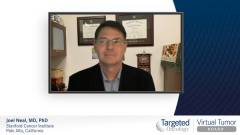
Biomarkers and Biomarker Testing in NSCLC
Zosia Piotrowska, MD, and Michelle Shiller, DO, AP/CP, MGP, explain the frequency of the different biomarkers in NSCLC, and steps clinicians might take to ensure timely and effective molecular testing for their patients.
Joel Neal, MD, PhD: Hello everybody, and thank you for joining us for this Targeted Oncology™ Virtual Tumor Board®. In today's presentation, my colleagues and I will review clinical cases of non-small cell lung cancer (NSCLC), discuss commonly observed targetable genomic alterations, and will share our perspectives on key clinical trial data that may impact treatment decision-making. I'm Dr Joel Neal. I'm an associate professor in the division of oncology at Stanford Cancer Institute in Palo Alto, California. Today I'm joined by Dr Zosia Piotrowska, Dr Michelle Shiller, and Lauren Welch, a nurse practitioner. Thank you for joining us, and let's get started.
When we think about biomarkers in non-small cell lung cancer, we're very excited that in 2022 we're up to actually 10 actionable biomarkers in lung cancer. What are these molecular biomarkers? Well, these are gene alterations in the cancer cells that cause cell proliferation, lack of cell death and are thought to be part of the fundamental underpinnings of tumorigenesis for the cells. Some of the biomarkers that we've often talked about over the last two decades are EGFR, followed closely by ALK then BRAF, KRAS, MET, NRG1, NTRK, RET, ROS1 and ERBB2. Dr Piotrowska, what's your sense of kind of the relative frequency of all of these? Which are the ones that you look out for most and want to make sure you rule out in patients with non-small cell lung cancer?
Zosia Piotrowska, MD: Well, I think there's certainly a spectrum here. Actually, the most common among these are the KRAS mutations which until just recently were not considered to be something that we could target and it's really exciting now to have drugs for a subset of patients with KRAS G12C mutations. I think after that the more common ones are EGFR mutations of various types and of course we'll talk about the different types of EGFR mutations today and ALK rearrangements or fusions. Then I think it's fair to say that many of the others are infrequent but when you put all of these together it's actually quite common now to find one of these targetable biomarkers in a patient with non-small cell lung cancer. While we have to acknowledge that many of these are uncommon, the least common being NTRK which is seen in less than one percent of patients with lung cancer, again it's so very important to do the testing to look for all of these regardless of their frequency because you're never going to find that needle in a haystack unless you look.
Joel Neal, MD, PhD: So that brings us to the question of testing and Dr Shiller – Michelle – I know that your specialty is molecular pathology and non-small cell lung cancer really paves the way for doing molecular testing in many of other solid tumor types. What do you think about in terms of some of the constraints of what do we need to make sure that we get effective molecular testing on patients with non-small cell lung cancer?
S. Michelle Shiller, DO, AP/CP, MGP: There are a couple of things to think about. First of all, most importantly, a multi-disciplinary dialog is integral to having a successful testing regimen. It needs to be understood by all people who come into contact with the patient or their tissue, that we need an adequate amount of tissue and that the timing of the results is critical to making sure that they are received in a meaningful time line so when patients follow up with the clinical providers such as yourselves, that we have the results to you so that you can make that decision together with the patient as to how they want to take the next step in their patient care journey. There's an abundance of data out there really supporting the use of broad genomic profiling because you see here this very long list of genes. So, to try to hit at that one individual gene at a time, first of all it's going to take a lot of time; secondly, we'll take a whole lot of tissue. Next generation sequencing has offered an opportunity to consider all of these questions with one piece of tissue fairly economically and with a compassionate use in terms of quantity of the tissue particularly when we are often dealing with advanced stage disease. We're often doing it with a needle biopsy rather than a resection and there's certainly different considerations between those different specimen types. All that to say, while next generation sequencing can answer many of the questions it's not always perfect at answering all of the questions so it is helpful to have orthogonal methods when for instance there may be a unique finding or when something is right at the borderline cut off to just try to dig a little bit deeper. That's kind of a broad general overview as to some of the things we think about as molecular pathologists partnering with you all for a successful treatment regimen.
Joel Neal, MD, PhD: As we get into our case today, we'll certainly focus on that conundrum especially when we get data evolving about the molecular testing at different points in time.










































